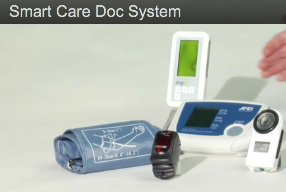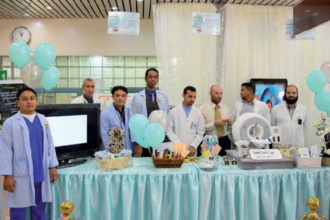Until recently, the specialized equipment, complexity and expensive network infrastructure required by video, as well as poor Medicare/Medicaid reimbursement policies made it impractical to utilize televideo technologies for the delivery of care unless the patient was a great distance from the doctor. Now, changing reimbursement models and the addition of low-cost desktop PC based televideo technologies, is making it easy and cost effective to utilize televideo in a wider array of patient and inter-clinician interactions.
Until recently, the specialized equipment, complexity and expensive network infrastructure required by video, as well as poor Medicare/Medicaid reimbursement policies made it impractical to utilize televideo technologies for the delivery of care unless the patient was a great distance from the doctor. Now, changing reimbursement models and the addition of low-cost desktop PC based televideo technologies, is making it easy and cost effective to utilize televideo in a wider array of patient and inter-clinician interactions. However, as SBR Health has learned over the past six months in talking with scores of health delivery organizations across the U.S, there are still many issues holding back the wider adoption and scale up of the use of televideo in the delivery of healthcare services. More importantly, we discovered that some of these issues were actually entwined with misconceptions that were leading to the failure to successfully deploy televideo to a wider audience.
Misconception #1: If televideo were cheaper, it would be more widely adopted.
This is sort of like saying if airplanes were cheap enough, everyone could buy one and commute into work. If you gave airplanes to everyone, this would still not solve the commute issue as how do people utilize the airplanes, where do they take off and land, how do you manage the air traffic, how do you train them to fly, etc. The real issue is congestion on the highways which lead to slow commute times, so what is needed is not cheaper forms of transportation, rather ways to reduce traffic congestion. In a similar regard, there are lots of free televideo technologies out in the marketplace, so expense is really a non-issue. The real issue is that the industry needs solutions that embody visual communications to facilitate the delivery of care in a more efficient and effective manner, NOT low cost televideo technology.
Misconception #2: Televideo technology is complex & difficult to use.
The real issue is that the traditional televideo technology available from the major vendors is complex, and not user friendly. Even my dad can use Skype video. He sees my picture in his address book, clicks on me, and we are in a code chat session. The real issue is that current televideo solutions, both the expensive high end hardware based systems and the low cost or free SIP based systems, do not overlay onto the existing clinical workflows. We found that a major factor holding back the use of televideo in delivery care was the lack of integration with currently established protocols and workflows, not an ease of use issue.
Misconception #3: Patients prefer in-person encounters.
In our market research we heard many stories of consumer preferences for televideo consults ranging from prison patients who prefer virtual rather than in person mental therapy, to busy parents that wanted to be able to video conference in to a consult with a nurse to discuss an ill child at school. Bottom line, it seems that what patients want is easier and quicker access to their care providers, and there are many instances where patients can’t or won’t travel into an ambulatory setting to see a physician either for a minor complaint, post-discharge follow-up, or chronic issue management, but they will show up for a virtual visit. In fact, one VA organization reported to us that they achieved almost 100% appointment adherence using televideo. As a recent John Hopkins study found that most health practices average a 42% no-show, you can clearly see that there is a huge untapped potential to use televideo to achieve more efficient use of physician resources just by eliminating no shows alone.
Misconception #4: If it is not reimbursable, then it doesn’t make sense to do it.
This one we found to be a real red herring. We discovered that in our encounters, organizations that were successfully deploying televideo at large scales had discovered operational efficiencies and business development benefits through the greater access provided with televideo technologies. This included increasing marketshare in rural and remote areas resulting in greater specialist utilization and patient referrals/transfers, freeing up doctors to spend more time treating sicker patients, eliminating down time for no shows, and losing less money on encounters they do not get fully reimbursed for. Additionally, integrated health delivery organizations and organizations transitioning to encounters of care, accountable care and patient centered medical home models are all successfully and rapidly expanding their services and clinical care models through the use of televideo technologies.
Misconception #5: Simple web conferencing can be used to deliver virtual clinic encounters.
One very strong pattern we noticed was that organizations who first deploy televideo, typically treat the encounter as a form of web or video conferencing, and that many of these initiatives fail to ‘take’ with clinicians and patients alike. The issue seems to be that their use of televideo in this manner does not fit their model of care. For instance, when utilizing larger legacy video conferencing technologies, physicians had to set aside blocks of time to do the virtual encounters, patients and doctors had to go to prescribed locations to do the virtual visit, and many issues arose over how to reschedule video connections and physical room locations when doctors ran late. When attempting to use lighter weight Skype like technologies, issues arose over how to make calls secure and authenticate users, prevent patients from calling at anytime, and how to maintain continuity when the doctor or patient is late to a call. For use in ad hoc specialist consults, there were added issues of how to route the calls to the right specialist, how to find the covering specialist, and how to handle transfer, queuing and forwarding of video calls. In short, you can’t view the encounter as a video conference – you have to view this as a clinical encounter that utilizes video as a communication modality, and the technology has to overlay and compliment the workflows rather than dictating them.







